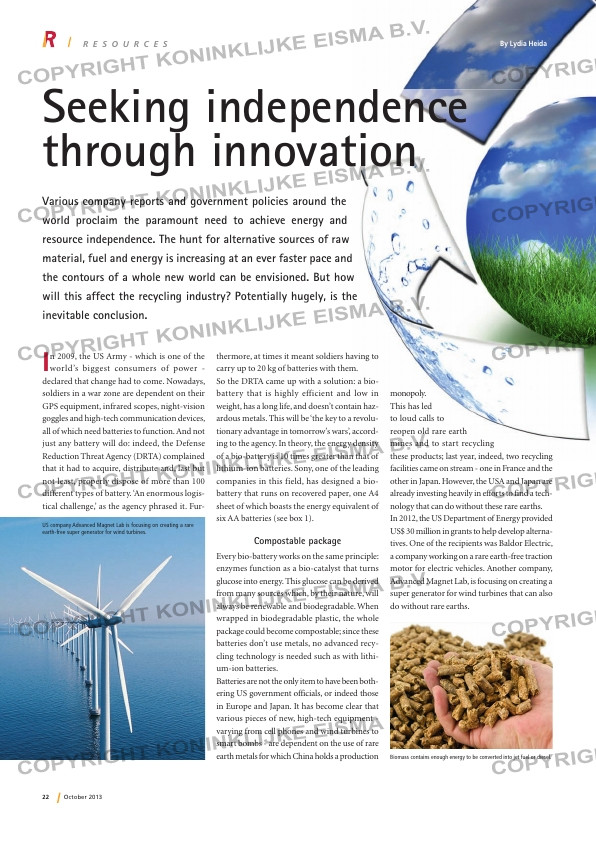Page 22 from: October 2013

22 October 2013
Various company reports and government policies around the
world proclaim the paramount need to achieve energy and
resource independence. The hunt for alternative sources of raw
material, fuel and energy is increasing at an ever faster pace and
the contours of a whole new world can be envisioned. But how
will this affect the recycling industry? Potentially hugely, is the
inevitable conclusion.
In 2009, the US Army – which is one of the world’s biggest consumers of power –
declared that change had to come. Nowadays,
soldiers in a war zone are dependent on their
GPS equipment, infrared scopes, night-vision
goggles and high-tech communication devices,
all of which need batteries to function. And not
just any battery will do: indeed, the Defense
Reduction Threat Agency (DRTA) complained
that it had to acquire, distribute and, last but
not least, properly dispose of more than 100
different types of battery. ‘An enormous logis-
tical challenge,’ as the agency phrased it. Fur-
thermore, at times it meant soldiers having to
carry up to 20 kg of batteries with them.
So the DRTA came up with a solution: a bio-
battery that is highly efficient and low in
weight, has a long life, and doesn’t contain haz-
ardous metals. This will be ‘the key to a revolu-
tionary advantage in tomorrow’s wars’, accord-
ing to the agency. In theory, the energy density
of a bio-battery is 10 times greater than that of
lithium-ion batteries. Sony, one of the leading
companies in this field, has designed a bio-
battery that runs on recovered paper, one A4
sheet of which boasts the energy equivalent of
six AA batteries (see box 1).
Compostable package
Every bio-battery works on the same principle:
enzymes function as a bio-catalyst that turns
glucose into energy. This glucose can be derived
from many sources which, by their nature, will
always be renewable and biodegradable. When
wrapped in biodegradable plastic, the whole
package could become compostable; since these
batteries don’t use metals, no advanced recy-
cling technology is needed such as with lithi-
um-ion batteries.
Batteries are not the only item to have been both-
ering US government officials, or indeed those
in Europe and Japan. It has become clear that
various pieces of new, high-tech equipment –
varying from cell phones and wind turbines to
smart bombs – are dependent on the use of rare
earth metals for which China holds a production
monopoly.
This has led
to loud calls to
reopen old rare earth
mines and to start recycling
these products; last year, indeed, two recycling
facilities came on stream – one in France and the
other in Japan. However, the USA and Japan are
already investing heavily in efforts to find a tech-
nology that can do without these rare earths.
In 2012, the US Department of Energy provided
US$ 30 million in grants to help develop alterna-
tives. One of the recipients was Baldor Electric,
a company working on a rare earth-free traction
motor for electric vehicles. Another company,
Advanced Magnet Lab, is focusing on creating a
super generator for wind turbines that can also
do without rare earths.
R e s o u R c e s By Lydia Heida
US company Advanced Magnet Lab is focusing on creating a rare
earth-free super generator for wind turbines.
Biomass contains enough energy to be converted into jet fuel or diesel.
Seeking independence
through innovation
p00_Recources.indd 22 03-10-13 09:54



